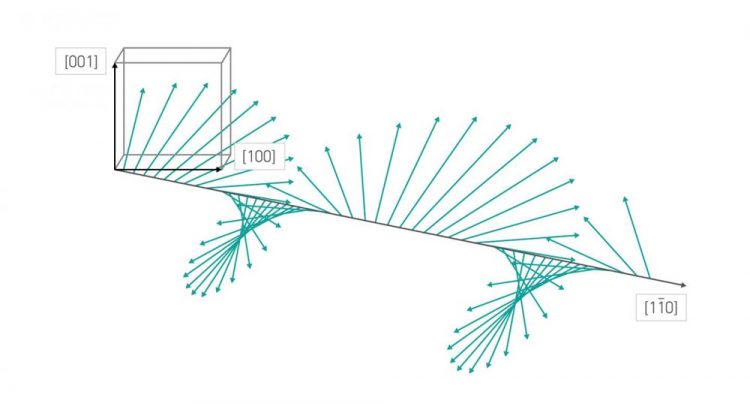Scientists explain how the giant magnetoelectric effect occurs in bismuth ferrite

Fig. 1. The spin cycloid structure in BiFeO3. Credit: MIPT press-office
A team of scientists from the Moscow Institute of Physics and Technology (MIPT), the National Research University of Electronic Technology (MIET), and the Prokhorov General Physics Institute have proposed a theoretical model that explains the unexpectedly high values of the linear magnetoelectric effect in BiFeO3 (bismuth ferrite) that have been observed in a number of experiments. The team also suggested a way of further enhancing the effect. The results of the study have been published in the journal Physical Review B.
One particular feature of bismuth ferrite is that in bulk samples, spins of Fe3+ iron ions are arranged in the form of a cycloid (Fig. 1). This spin structure can be destroyed by a strong magnetic field or mechanical stress. Without a spin cycloid, bismuth ferrite exhibits a large linear magnetoelectric effect, and this effect was the focal point of the study.
“The theoretical description presented in the paper may be applicable to other multiferroics similar to BiFeO3. This will help in predicting the value of their magnetoelectric effect, which, in turn, will make it easier to find new and promising materials for industrial applications,” says the head of MIPT's Laboratory of physics of magnetic heterostructures and spintronics for energy-saving information technologies, Prof. Anatoly Zvezdin.
Multiferroics and the magneto electric effect
Multiferroics are materials that simultaneously exhibit different ferroic orders, including magnetic, ferroelectric and/or ferroelastic. If there is an interaction between electric and magnetic subsystems in a material, a magnetoelectric (ME) effect may occur.
The magnetoelectric effect is when electric polarization occurs under the influence of an external magnetic field and magnetization occurs under the influence of an electric field. This allows an electric field to be used to control the magnetic properties of a material and a magnetic field to be used to control the electric properties. If the value of the ME effect is high (dozens or hundreds of times higher than normal), it is called a giant ME effect.
The main use of the magnetoelectric effect is in variable and static magnetic field sensors. These sensors are used in navigation systems, electric motors, and also in vehicle ignition systems. Compared to similar devices based on the Hall effect or magnetoresistance, sensors based on the ME effect are more sensitive (according to research, up to one million times more sensitive) and they are also relatively cheap to manufacture.
The ME effect offers exciting possibilities for the use of multiferroics in new types of magnetic memory, e.g. ROM – read only memory. The ME effect could also potentially be used to create high-precision equipment for working with radiation in the microwave range, and to wirelessly transmit power to miniaturized electronic devices.
Bismuth ferrite
The subject of the study was bismuth ferrite (BiFeO3) – a highly promising multiferroic that is very promising in terms of its practical applications. It is planned to be used to create ultra energy-efficient magnetoelectric memory.
In addition, bismuth ferrite exhibits a magnetoelectric effect at room temperature, while in most other magnetoelectrics an ME effect of this magnitude is only observed at extremely low temperatures (below -160 degrees Celsius). Bismuth ferrite is an antiferromagnetic, which means that the magnetic moments of its magnetic sublattices (structures formed by atoms with the same parallel spins) cancel each other out, and the total magnetization of the material is close to zero. However, the spatial arrangement of the spins forms the same cycloidal spin structure (Fig. 1).
In the 1980s it was thought that this multiferroic exhibited only a quadratic magnetoelectric effect (i.e. polarization is quadratically proportional to the applied magnetic field). The fact that the linear magnetoelectric effect “went unnoticed” for a long time had to do with the spin cycloid (Fig. 1): due to the spin cycloid structure, certain characteristics, such as magnetization and the magnetoelectric effect “average out” to zero. However, when bismuth ferrite is placed in a strong magnetic field (greater than a certain critical value), the structure is destroyed and this is accompanied by the emergence of a linear ME effect (when polarization is linearly proportional to the applied field).
Early experiments indicated a low value of the linear magnetoelectric effect in bismuth ferrite (almost one thousand times lower than the actual value), however later experimental studies revealed a large ME effect and it was also demonstrated that by using it in layered structures, record values of the magnetoelectric effect can be achieved.
The authors of the paper developed a theoretical justification for the occurrence of the linear ME effect based on the Ginzburg-Landau theory and explained the previously large experimental value of the effect. As part of their theory, the researchers also showed that the ME effect could be enhanced in the presence of an electrostatic field.
Media Contact
All latest news from the category: Physics and Astronomy
This area deals with the fundamental laws and building blocks of nature and how they interact, the properties and the behavior of matter, and research into space and time and their structures.
innovations-report provides in-depth reports and articles on subjects such as astrophysics, laser technologies, nuclear, quantum, particle and solid-state physics, nanotechnologies, planetary research and findings (Mars, Venus) and developments related to the Hubble Telescope.
Newest articles

NASA: Mystery of life’s handedness deepens
The mystery of why life uses molecules with specific orientations has deepened with a NASA-funded discovery that RNA — a key molecule thought to have potentially held the instructions for…

What are the effects of historic lithium mining on water quality?
Study reveals low levels of common contaminants but high levels of other elements in waters associated with an abandoned lithium mine. Lithium ore and mining waste from a historic lithium…

Quantum-inspired design boosts efficiency of heat-to-electricity conversion
Rice engineers take unconventional route to improving thermophotovoltaic systems. Researchers at Rice University have found a new way to improve a key element of thermophotovoltaic (TPV) systems, which convert heat…



